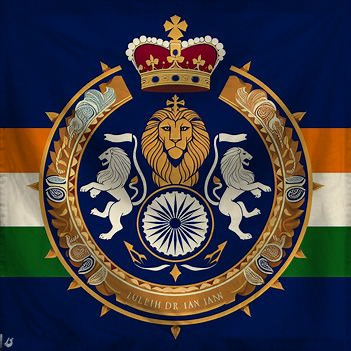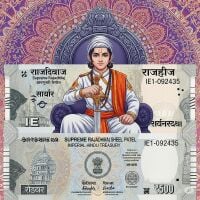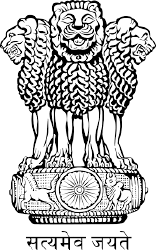The Hindu Empire of the Imperial Patel Empire is a sovereign, absolute monarchy founded by the Supreme Rajadhiraja Sheel Patel, who unified the 750-square-mile heartland surrounding Majestica (Ahmedabad) and Suryanagara (Bareja). Rooted in the ancient principles of Rajadharma and inspired by the cultural legacy of Vedic and Gujarati civilization, the Empire blends traditional Hindu values with modern statecraft. The Rajadhiraja rules with near-absolute authority, seen as both divine protector of Dharma and steward of the people's prosperity.
The empire is governed through a centralized bureaucracy supported by noble houses, military leaders, and a priestly caste of advisors. With a strong mixed economy, the Empire thrives on textiles, agriculture, trade, renewable energy, and artisan crafts, guided by the imperial Patel Group and its network of guilds and businesses. Infrastructure is rapidly advancing, fueled by technological innovation and state-backed investment.
Culturally vibrant and religiously rich, Hinduism forms the moral and spiritual backbone of the state. While Gujarati is the dominant language, Sanskrit is used for religious and official matters, and Hindi functions as a tertiary tongue. The population is majority Gujarati Hindu, with respected minorities including Muslims and Jains. Imperial law blends spiritual doctrine with pragmatic governance, creating a society grounded in tradition, order, and ambition.
From sacred peaks to solar farms, the Empire stands as a rising power—guided by Dharma, driven by unity, and destined for greatness.
| National Factbook |
| Flag: |

|
| Nation Name: |
The Imperial Patel Empire |
| Leader Name: |
Sheel Patel |
| Currency: |

Dharmajya |
| National Animal: |

Asiatic Lion |
| History: |
📜 The Founding History of the Imperial Hindu Empire
Under the Supreme Rajadhiraja Sheel Patel
Day 1 of Rule | Capital: Majestica (Ahmedabad)
🌄 Before the Empire: The Fractured Lands
For centuries, the land now united under your banner was a divided region—a mosaic of city-states, trade guilds, warlords, and fading royal lineages. Once home to mighty kingdoms in ancient times, the heartland of Ahmedabad lost its unity as foreign powers, internal corruption, and sectarian conflict eroded its strength.
Though rich in culture, agriculture, and divine heritage, the region suffered under the weight of petty rulers and foreign puppets. Great temples fell into disrepair, dharma was diluted, and the people lived in anxious peace under ever-shifting banners.
🐘 The Rise of the Patels
Among these fragments emerged House Patel, a noble family of warrior-scholars and disciplined visionaries. Their ancestral seat in Golden Vale became known not just for its fertile fields, but for its well-trained militia, disciplined governance, and rising trade economy under the Patel Group—a network of farming, trade, innkeeping, and estate development.
It was here that Sheel Patel, a military captain, strategist, and statesman, rose not just by sword—but by law, diplomacy, and vision. Uniting fractured noble houses through diplomacy, trade alliances, and decisive military victories, he gained the loyalty of both soldiers and scholars.
🕉️ The Declaration of Empire
On the morning of the 1st day of his reign, from the sacred citadel of Majestica (formerly Ahmedabad), Sheel Patel declared the formation of a new era:
"Let this land no longer be scattered, but united under Dharma, strength, and wisdom. From this day forward, I, Sheel of House Patel, stand as the First Supreme Rajadhiraja—protector of the people, preserver of dharma, and servant of the gods."
In a grand ritual beneath the golden flag of the empire, the priests of Vishnu, Shiva, and Surya anointed him with sacred waters. Bells rang across the land, signaling the beginning of a new imperial calendar: Year 0 of the Hindu Imperial Era.
🏛️ The Structure of the Empire (750 sq. miles)
Capital City: Majestica – seat of the palace, court, and Rajamandala Coliseum.
Regions: Divided into 5 provinces, each with appointed Rajadharma Governors.
Imperial Guard: Formed from elite military units loyal only to the Supreme Rajadhiraja.
Faith and Law: Governed by a fusion of Rajadharma, Dharmaśāstra, and modern code.
National Language: Sanskrit (ceremonial), Gujarati (administrative), with recognition of all regional tongues.
🔱 First Decrees Issued on Day 1
Abolition of torture
Foundation of free healthcare for all citizens
Declaration of progressive tax code based on dharma
Establishment of Rajamandala Coliseum as the center of culture and sport
The naming of the official Imperial Baseball Team: The Golden Varunas
🌅 What Lies Ahead
With Day 1 complete, the Empire stands on the brink of greatness. Diplomacy, economics, and spiritual revival await. Enemies may still linger in the shadows—jealous nobles, foreign powers, or hidden cults—but for now, the land has found its unifying force:
The Empire of Dharma, Strength, and Order
Led by Sheel Patel — First Supreme Rajadhiraja |
| Geography |
| Continent: |
Asia |
| Land Area: |
3,218.68 sq. km |
| Terrain: |
🏞️ Imperial Terrain Overview
Region: Centered in Gujarat, India
Radius: 2,000 sq. miles
Major Cities: Majestica (Ahmedabad), Suryanagar (Bareja), Najapura (Naj, Daskroi)
🏛️ Majestica (Ahmedabad) – The Capital
Terrain Type: Flat alluvial plains
Features:
Fertile land, ideal for agriculture
Interlaced by the Sabarmati River
Urbanized core surrounded by cultivated fields and temple groves
Elevation: ~50–60 meters above sea level
Soil: Black and alluvial soil, excellent for cotton, wheat, and millet
🌞 Suryanagar (Bareja) – City of Light & Energy
Terrain Type: Gently rolling semi-arid terrain
Features:
Open plains with occasional rocky outcrops
Ideal for solar farms and wind installations
Scattered scrub forests and rural villages
Elevation: ~48–55 meters
Soil: Sandy loam with irrigation-supported farming (vegetables, cumin, mustard)
🕊️ Najapura (Naj, Daskroi) – The Garden Frontier
Terrain Type: Transitional landscape — fertile lowlands and marshy zones
Features:
Fields, canals, and man-made lakes (tanks)
Lush greenery, smaller tributaries, and occasional banyan groves
Known for lotus fields and dairy cooperatives
Elevation: ~45–50 meters
Soil: Moist black soil, excellent for rice, sugarcane, and vegetables
|
| Highest Peak: |
Mt. Girnar, 1,069 meters |
| Lowest Valley: |
Nal Sarovar Wetlands, 23 meters |
| Climate: |
🌤️ Climate of the Hindu Empire of the Imperial Patel Empire
Climate Type: Tropical Savanna (Aw) – with Semi-Arid (BSh) elements
| Season | Months | Description |
| -------------------- | ---------------- | -------------------------------------------------------------------------------- |
| 🌞 **Summer** | March – June | Very hot and dry; temperatures peak at **42–46°C (107–115°F)** in May |
| 🌧️ **Monsoon** | Late June – Sept | Heavy rainfall due to the southwest monsoon; **high humidity**, scattered floods |
| 🌤️ **Post-Monsoon** | Oct – Nov | Pleasant, clear skies, cooling temperatures |
| ❄️ **Winter** | Dec – Feb | Mild and dry; temps drop to **10–15°C (50–59°F)** at night, **25–28°C** by day |
| Measure | Value |
| ------------------------- | ------------------- |
| **Average High (Summer)** | 42–44°C (107–111°F) |
| **Average Low (Winter)** | 9–12°C (48–54°F) |
| **Annual Mean Temp** | 27°C (80°F) |
| Detail | Value |
| --------------------- | ---------------------------------------------------------- |
| **Annual Rainfall** | 700–1,200 mm (28–47 inches) |
| **Rainy Months** | July – September |
| **Flood-Prone Zones** | Near Najapura & Sabarmati banks during heavy monsoon years |
💨 Winds & Storms:
Summer Winds: Hot, dry winds locally called loo
Monsoon Winds: Moist southwesterlies
Occasional cyclonic influence from the Arabian Sea, though rare inland
🌾 Impact on Empire:
Agriculture depends on monsoon rains and imperial irrigation projects
Solar energy thrives in Suryanagar’s dry plains
Water conservation (stepwells, canals) is essential to manage drought cycles |
| People & Society |
| Population: |
146,710 people |
| Demonym: |
Pateliyan |
| Demonym Plural: |
Pateliyans |
| Ethnic Groups: |
Gujarati - 87.0%
Gujarati Muslims - 8.5%
Jains - 3.0% |
| Languages: |
Gujarati - 87.0%
Sanskrit - 6.5%
Hindi - 4.0% |
| Religions: |
Hinduïsm - 82.5%
Islam - 11.0%
Jainism - 3.0% |
| Health |
| Life Expectancy: |
70 years |
| Obesity: |
12.5% |
| Alcohol Users: |
22.5% |
| Tobacco Users: |
27.5% |
| Cannabis Users: |
4% |
| Hard Drug Users: |
1% |
| Economy |
| Description: |
🏛️ Economic System of the Imperial Hindu Empire
Mixed Market Economy with Strong Capitalist Foundations
Key Features:
Capitalist core:
Thriving trade, artisanal crafts, agriculture, and growing urban commerce.
Private ownership and entrepreneurship encouraged, especially among merchant castes and guilds.
Emerging industrial sectors supported by imperial investments.
State involvement:
Government actively funds infrastructure, education, healthcare, and technology projects.
Strategic sectors like energy (alternative sources), transportation, and defense are regulated or partially state-controlled.
Progressive taxation and welfare programs help maintain social stability.
Socialist elements:
Welfare safety nets for impoverished citizens, including healthcare and education access.
Community service programs and mandates encourage social cohesion.
Traditional economy components:
Some barter and informal exchanges persist, especially in rural or tribal areas.
Agricultural cooperatives and guild-like structures manage production and trade locally.
Not Socialist/Communist/Anarchist:
No collectivization or state ownership of all means of production.
No anarchic absence of government control; imperial authority is strong and centralized.
Summary:
This empire practices a regulated capitalist economy with significant social welfare and imperial oversight to maintain order, prosperity, and dharma.
|
| Average Yearly Income: |
$49.69 |
| Gross Domestic Product (GDP): |
$599,460,249.00 |
| GDP per Capita: |
$4,085.98 |
| Gross National Income (GNI): |
$485,162,380.00 |
| Industries: |
🏭 Major Industries of the Imperial Hindu Empire
1. Textiles & Apparel
Real-world basis: Ahmedabad is historically known as the "Manchester of India" for its booming textile industry.
Empire focus:
Cotton weaving, dyeing, and printing (traditional block printing).
Silk and fine fabric production for royal garments and trade.
Artisanal embroidery and handcrafted fabrics supporting local artisans.
2. Agriculture & Agro-processing
Real-world crops: Cotton, millet, wheat, sugarcane, pulses, and oilseeds.
Empire focus:
Large-scale farming with imperial irrigation projects.
Agro-processing for sugar, oil extraction, and grain milling.
Export of spices, dried fruits, and traditional herbal products.
3. Jewelry & Gemstone Crafting
Gujarat has a rich tradition of jewelry-making and precious stone trade.
The empire sponsors elite artisans crafting intricate gold, silver, and gemstone jewelry for nobility and export.
4. Renewable Energy & Solar Power
Empire’s modern initiative: Solar farms in Suryanagara’s “Solar Gardens.”
Focus on sustainable energy development, reducing coal dependency.
5. Pharmaceuticals & Ayurveda
Growing industry blending traditional Ayurvedic medicine with modern pharmaceuticals.
Export of herbal remedies, oils, and medicinal plants.
6. Trading & Shipping
Gujarat’s historical role as a trade hub is continued with imperial backing.
Commerce routes connecting inland cities with ports on the Arabian Sea.
Trade in textiles, spices, gems, and exotic goods.
7. Handicrafts & Pottery
Traditional crafts like bandhani textiles, pottery, and woodwork flourish, supported by guilds.
8. Technology & Infrastructure
Growing sector focused on urban development, irrigation systems, and imperial projects.
Technological advancement supported by government grants and projects.
| Industry | Real-World Basis | Imperial Emphasis |
| ---------------------- | ------------------------------- | --------------------------------------- |
| Textiles & Apparel | Cotton mills & silk weaving | Royal fabrics & artisanal craftsmanship |
| Agriculture | Cotton, sugarcane, wheat | Large-scale farming & agro-processing |
| Jewelry & Gem Crafting | Traditional gold & gems trade | Imperial patronage & export |
| Renewable Energy | Emerging solar power in Gujarat | Solar farms & sustainability efforts |
| Pharmaceuticals | Ayurveda & herbal medicine | Blended traditional & modern pharma |
| Trading & Shipping | Gujarat’s historic trade ports | Inland commerce & Arabian Sea trade |
| Handicrafts & Pottery | Bandhani, pottery, woodwork | Guilds & royal crafts markets |
| Technology & Infra | Urban growth and irrigation | Imperial infrastructure projects |
|
| Military |
| History: |
🛡️ Military Forces of
The Hindu Empire of the Imperial Patel Empire
Real-Life Context & Establishment
Inspired by: The historical military traditions of Gujarat and broader Indian subcontinent forces, including Rajput and Maratha martial legacies.
Modern foundation: The empire’s standing military was officially established following the decisive 1st Supreme Rajadhiraja Sheel Patel’s peaceful consolidation of power—a “coup” in the sense of unifying fractured territories around Ahmedabad (Majestica) and Bareja (Suryanagara).
Year of establishment: Let’s say Year 1 of the Imperial Era (IE 1), marking your first day as Supreme Rajadhiraja.
Composition of the Military Forces
Royal Guard (Rajaputra Regiment):
Elite personal guard of the Rajadhiraja and imperial family.
Highly trained in traditional weaponry (swords, bows) and modern tactics.
Imperial Infantry:
Main land force, composed of regional levies and professional soldiers.
Equipped with a mix of traditional arms and contemporary firearms.
Cavalry Corps:
Horse-mounted units drawing on Rajput and regional cavalry traditions.
Used for rapid flanking, reconnaissance, and shock tactics.
Artillery Division:
Includes traditional siege weapons and modern artillery.
Essential for fortress defense and field battles.
Navy:
Small but strategic coastal defense force controlling trade routes near the Arabian Sea.
Patrols key ports and protects merchant fleets.
Engineering Corps:
Responsible for constructing fortifications, roads, and military infrastructure.
Supports both military campaigns and imperial projects.
Military Doctrine & Culture
Rajadharma-inspired code: Emphasizes honor, duty, and protection of the dharma (moral order).
Combination of ancient martial arts and modern strategy: Martial training includes swordsmanship, archery, pressure locks, and newer tactics.
Conscription policy: All able-bodied adults serve mandatory military or community service.
| Aspect | Details |
| -------------- | ---------------------------------------------------------- |
| Founded | IE 1, after unification under Sheel Patel |
| Core Units | Royal Guard, Infantry, Cavalry, Artillery, Navy, Engineers |
| Military Ethos | Rajadharma, honor, defense of dharma |
| Service | Mandatory military or community service |
|
| Soldiers: |
0 |
| Tanks: |
0 |
| Aircraft: |
0 |
| Ships: |
0 |
| Missiles: |
0 |
| Nuclear Weapons: |
0 |
| Last Updated: 06/22/2025 11:07 am |


















